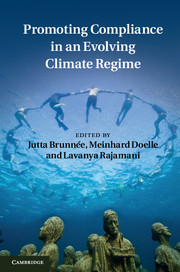Book contents
- Frontmatter
- Contents
- Contributors
- Preface
- Abbreviations
- Introduction: The role of compliance in an evolving climate regime
- Part I Context
- Part II The Kyoto compliance system: Features and experience
- 4 Key features of the Kyoto Protocol’s compliance system
- 5 Experience with the facilitative and enforcement branches of the Kyoto compliance system
- 6 Experiences with Articles 5, 7, and 8 defining the monitoring, reporting and verification system under the Kyoto Protocol
- Part III Compliance and the climate regime: Issues, options, and challenges
- Part IV A look forward
- Bibliography
- Index
- References
4 - Key features of the Kyoto Protocol’s compliance system
Published online by Cambridge University Press: 05 January 2012
- Frontmatter
- Contents
- Contributors
- Preface
- Abbreviations
- Introduction: The role of compliance in an evolving climate regime
- Part I Context
- Part II The Kyoto compliance system: Features and experience
- 4 Key features of the Kyoto Protocol’s compliance system
- 5 Experience with the facilitative and enforcement branches of the Kyoto compliance system
- 6 Experiences with Articles 5, 7, and 8 defining the monitoring, reporting and verification system under the Kyoto Protocol
- Part III Compliance and the climate regime: Issues, options, and challenges
- Part IV A look forward
- Bibliography
- Index
- References
Summary
Introduction
The compliance system of the United Nations Framework Convention on Climate Change (FCCC’s) Kyoto Protocol is based on four layers of rules that have been developed in several steps. First, an enabling clause (Article 18) in the protocol mandates the Conference of the Parties serving as the meeting of the parties to the Kyoto Protocol (CMP) to approve appropriate and effective procedures and mechanisms to determine and address cases of non-compliance. On this basis, CMP-1 approved and adopted the procedures and mechanisms relating to compliance under the protocol (Compliance Procedures). The Compliance Committee, established by the Compliance Procedures, then developed, and the CMP adopted, further rules of procedure (Rules of Procedure). In addition, the committee has developed working arrangements to complement and give effect to the Rules of Procedure.
In this chapter, we aim to demonstrate that the protocol’s compliance system and the experience gained from its operation since 2006 constitute a landmark in international climate policy and global environmental governance more broadly. The compliance system forms an integral part of the governance system of the protocol and provides for an unprecedented administrative review, by an independent international body, of state action to implement the protocol. It is unique for multilateral environmental agreements (MEAs), especially because of its objective to enforce as well as to facilitate and promote compliance. Beyond its role in ensuring compliance with the protocol’s emission targets, it is an essential component in securing the accurate ‘measurement, reporting, and verification’ of greenhouse gas emissions under the protocol and the effective functioning of its carbon-market mechanisms. With more than five years of practical operation behind it since 2006, the compliance system has further matured and proved that an independent international review of state action can be efficacious in promoting compliance with an MEA – even though some weaknesses in the system have also become evident during this period.
- Type
- Chapter
- Information
- Promoting Compliance in an Evolving Climate Regime , pp. 77 - 101Publisher: Cambridge University PressPrint publication year: 2011



